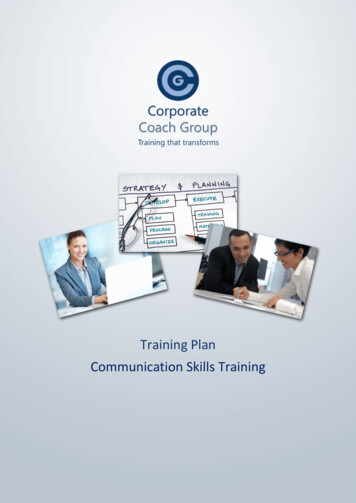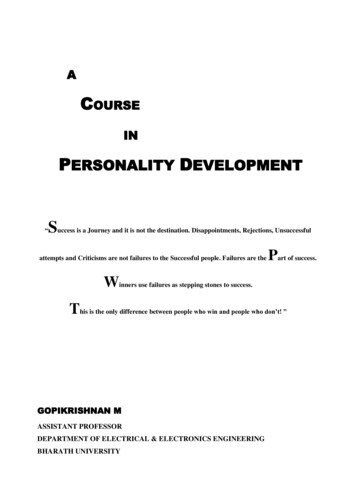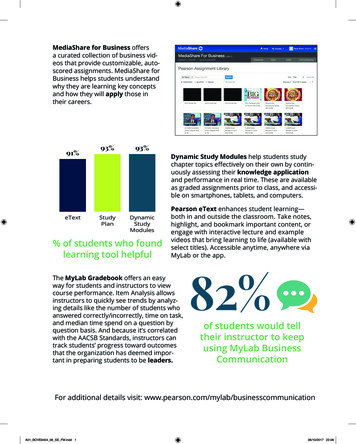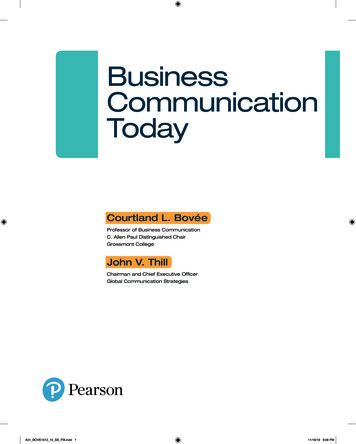
Transcription
Skills for EffectiveBusiness Communication:Efficiency, Collaboration, and SuccessMichael MurphyShorenstein Center for CommunicationKennedy School of GovernmentHarvard UniversitySeptember 30, 2014MurphySkills for Effective Business CommunicationHKS at Harvard University 30SEP14
I: IntroductionCommunicativeCompetence and SelfAssessmentII: Strategies for EfficientReadingIII. Strategies forImproving Writing Define the term “business communication;” Identify the elements of communication from asocio-linguistic perspective; Assess individual strengths and weaknesses in termsof communication skills. Structure approaches to reading a text;Identify tips to increase speed as a reader;Apply the strategies to a text.Note the importance of giving and receivingfeedback; Identify the “7Cs of Effective Business Writing;” Structure emails from subject heading to sign off; Note the limits of technology for writers and thedangers of excessive use of business jargon.IV: On The Phone:Non-Verbal Skills andCollaborativeRelationships in the VirtualOffice Note the importance of non-verbal communication; Identify strategies for effective communication invirtual meetings; Examine current trends and predict future changesin business communication.V. Conclusion Acknowledge the relationships between language,efficiency, collaboration, and success!Murphy Skills for Effective Business Communication HKS at Harvard University 30SEP142
Communication is the key to success in business.Business communication is the ability to build solidrelationships based on the effective and efficientexchange of information between:Vendors anddistributorsOtherbusinessesEmployeeswithin thebusinessCustomersand clientsIn other words, it’s all about building trust.MurphySkills for Effective Business CommunicationHKS at Harvard University 30SEP143
Four SociolinguistCompetencies al, syntactic,semantic,morphological,and uisticCompetenceStrategicCompetenceThe combination oflinguistic expressionsand the appropriateway of connectingthese expressions.Communication in asocial and culturalcontext with awarenessof theme, roles,participants, situationand norms ofinteraction.The ability tosolvecommunicationproblems andcompensate fordeficiencies byverbal and nonverbal means.MurphySkills for Effective Business CommunicationHKS at Harvard University 30SEP14Adapted from Canale & Swain (1988)4
On The Relationships Between Face-to-Face and VirtualCommunication and Verbal and Non-verbalCommunication:Cummins’s (1981b) model of language acquisition (as cited in Madyarov) with four quadrants.MurphySkills for Effective Business CommunicationHKS at Harvard University 30SEP145
The Interdependent Nature of Communication withRegard to Input and Output:Output (Has)WriterSpeaker Clarity; Succinctness; Professionalism; Structural, syntactic,and lexicalperfection; Information. Clarity; Brevity; Succinctness; Accuratepronunciation, tone,and style.MurphySkills for Effective Business CommunicationHKS at Harvard University 30SEP14Input (Is)COMMUNICATION Active; Engaged; Aware; Involved; Responsive. Active; Engaged; Aware; Involved; Responsive.ReaderListener6
Strategies for Efficient Reading (Part 1 of 3):Preview:Skim:Cluster:MurphySkills for Effective Business CommunicationHKS at Harvard University 30SEP14 Read the title/subject line: Determine what thetext is about; Read the first two paragraphs and the firstsentence of each subsequent paragraph; Read the concluding paragraph. If it’s short enough, look for keys words; Use text features such as bold or italics. Train your eyes to read in groups of four tofive words rather than one-by-one.Cosby, B. (1982). How to read faster. “Power of the Printed Word.” International Paper Company.Retrieved from f9
Strategies for Efficient Reading (Part 2 of 3):Conduct a STAP Analysis:Identify the Subject:Identify the Thesis: The subject is usually one word. What is the author’s attitude/opinionabout the subject?Identify the Audience: Evaluate the tone, vocabulary, and syntaxto determine the audience.Identify the Purpose: Determine whether the author iscomplaining, informing, evaluating,explaining, etc.MurphySkills for Effective Business CommunicationHKS at Harvard University 30SEP148
The “7 Cs of Effective Business Writing”(Part 1 of 6):Concreteness:Use specificwords andavoid eteness:Check for the 5W’sThe “7 Cs ofEffectiveBusinessWriting”Correctness:Include onlyaccurate factsClarity:Apply the“K-I-S-SPrinciple”Courtesy:Be thoughtfuland positiveConsideration:Focus on “you”instead of “I”Ohio University. College of Business. Business writing skills. Communication Standards. Retrieved fromMurphySkills for Effective Business Communication s1%20business%20writing%20skills.docHKS at Harvard University 30SEP149
Phone Etiquette:Use Signaling Phrases (say):“Let me ask a question”“Let me suggest ”“Let me clarify .”“Let me summarize .”MurphySkills for Effective Business CommunicationHKS at Harvard University 30SEP14 (do):Then, ask the question Then, make the suggestion .Then, make the clarification Then, summarize thediscussion .10
Phone Etiquette (Cont.)Use ActiveListeningTechniquesAsk forDetails:“Give memore detailsabout that ”“Tell memore aboutthat .”MurphySkills for Effective Business CommunicationHKS at Harvard University .”“I understandwhat youmean.”AskQuestions:“What didyou donext?”“How didyourespond?”11
Summary Get feedback from colleagues and clients on your communication skills.Give feedback to your colleagues and clients.Recognize the limits of technology.Be positive.Remember that efficiency is a skill to be mastered.Remember that collaboration is key to building strong relationships.Remember that the success of the individual and the organization dependson effective communication!Thank you!MurphySkills for Effective Business CommunicationHKS at Harvard University 30SEP1412
in business communication. IV: On The Phone: Non-Verbal Skills and Collaborative Relationships in the Virtual Office Acknowledge the relationships between language, V. Conclusion efficiency, collaboration, and success! Murphy Skills for Effective Business C










